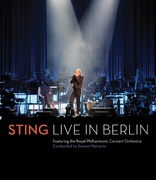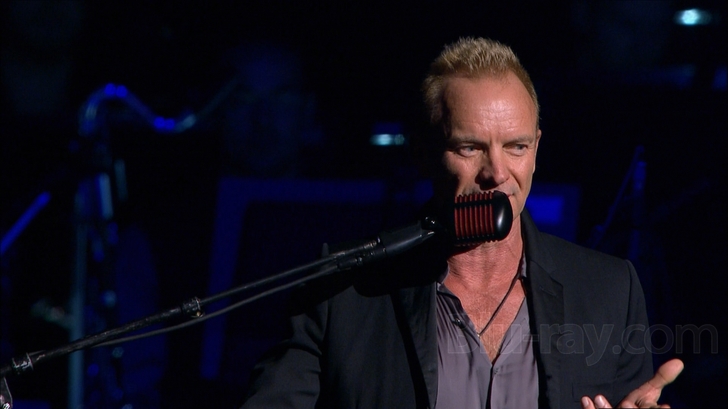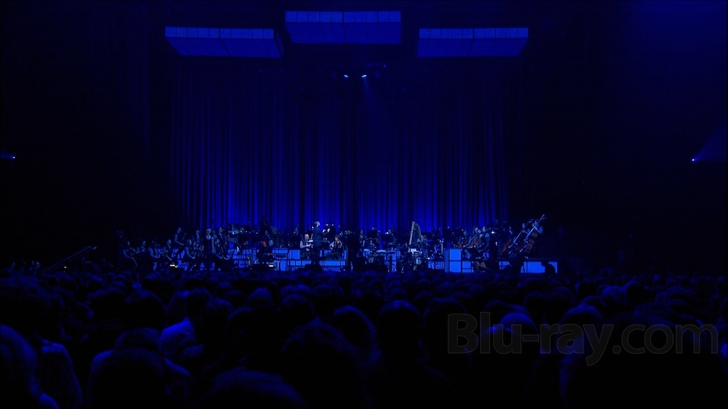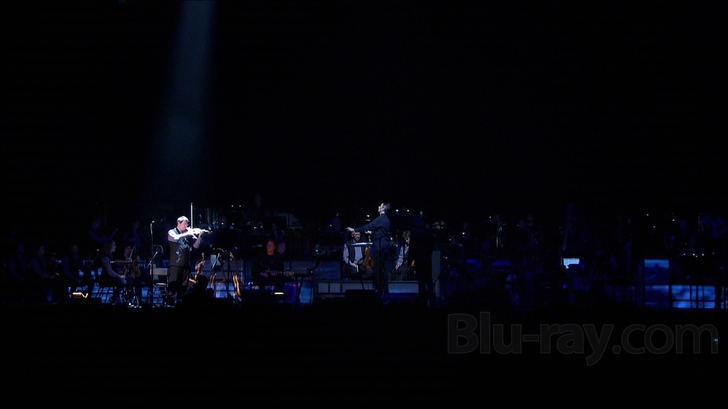Sting: Live in Berlin Blu-ray Movie
HomeSting: Live in Berlin Blu-ray Movie 
Decca | 2010 | 125 min | Unrated | Nov 22, 2010
Movie rating
8.2 | / 10 |
Blu-ray rating
| Users | 4.2 | |
| Reviewer | 4.0 | |
| Overall | 4.2 |
Overview
Sting: Live in Berlin (2010)
Sting's Symphonicity tour with the Royal Philharmonic Concert Orchestra performs in Berlin.
Starring: Sting| Music | 100% |
Specifications
Video
Video codec: MPEG-4 AVC
Video resolution: 1080i
Aspect ratio: 1.78:1
Original aspect ratio: 1.78:1
Audio
Music: DTS-HD Master Audio 5.1 (96kHz, 24-bit)
Music: LPCM 2.0 (96kHz, 24-bit)
Subtitles
None
Discs
25GB Blu-ray Disc
Single disc (1 BD)
Playback
Region free
Review
Rating summary
| Movie | 4.0 | |
| Video | 4.0 | |
| Audio | 5.0 | |
| Extras | 2.0 | |
| Overall | 4.0 |
Sting: Live in Berlin Blu-ray Movie Review
Sting goes orchestral.
Reviewed by Jeffrey Kauffman November 30, 2010A&M Records holds a special place in the hearts of many music fans who grew up in the 1960s and 1970s. The diametric opposite of corporate giants like Columbia and Capitol, A&M had more of an ‘individual’ presence and always seemed to emanate a sort of family affair feeling with its roster of talent. What started as a garage-based sort of hobby, sort of business for trumpeter Herb Alpert and his partner Jerry Moss soon grew to be the largest independent record company in the world. In fact, when Alpert and Moss sold their interest in A&M decades later, the deal fetched each of them a cool half billion dollars. (That’s billion with a “b”). But in the early years A&M was known mostly for its middle of the road presence, especially with regard to Alpert’s Tijuana Brass, an “easy listening” consortium that nonetheless was one of the few bands in the 1960s which managed to appeal to both adults and kids. In fact for a while the TJB, as they were affectionately known in those days, handily outsold The Beatles, even at the height of the British Invasion. A&M slowly grew its roster with a number of huge acts, most notably Sergio Mendes & Brasil ’66, who helped establish the label with international and more sophisticated, jazz leaning audiences (in fact many early fans of the label assumed the “M” in the imprint was for Mendes). Even Sergio’s early records, as relatively jazzy as they were, toed a pretty fine line centered around easy listening, but after the 1967 Monterey Pop Festival, A&M started seriously branching out, signing a number of important rock acts even as they continued to mine what soon became known as Adult Contemporary. Even their long established acts, like Brasil ’66, started experimenting with bolder sounds, as exemplified by Mendes’ extremely trippy psychedelic 7 minute “Crystal Illusions,” off of his 1969 album of the same name. While the 1970s saw A&M maintaining its adult oriented mainstream presence with their supergroup Carpenters (Richard and Karen did not like that The which people tended to put in front of their surname), the label had outgrown their Adult Contemporary roots, as evidenced by both the Tijuana Brass and Brasil ’66, which had since morphed into Brasil ’77, either disbanding or leaving the label. The 1970s saw a glut of important rock groups join the label, including Styx and Supertramp, but it was another “S” presence, albeit one initially associated with a group, who would become perhaps A&M’s most lasting contribution to late 20th century popular music. That of course was Sting, the lead presence of A&M’s multi-platinum band The Police.

Gordon Sumner, the more prosaic name for the man who would achieve worldwide superstardom as Sting, obviously always had more than “merely” rock and roll on his mind. His early efforts with The Police were often unusually literary, and his changes, even from the earliest songs, mined the worlds of jazz, gospel, blues and pop in an inviting mélange of styles that kept The Police cutting edge for far longer than some of their Top 40 compatriots. Sting of course soon branched out into film and then a solo career that saw him spreading his wings even further into a jazz inflected world where he sang and played alongside a host of luminaries. Sting’s musical presence has become so prominent than none other than the Chicago Symphony approached him sometime ago to develop a “Symphonic Sting” evening as a part of their annual fundraising activities. That initial concert was so successful that Sting opted to take it on tour, and it’s that combination of elements that is presented on this enjoyable, if sometimes affected, Berlin outing. What may strike some fans, especially those who know the history of A&M, is how Sting in this setting seems to have smoothed out some of the rough, almost punk, edges that first defined his rock image. Is Sting making "easy listening" music all of a sudden?
Sting has often struck me as a sort of male counterpart to Joni Mitchell. Mitchell herself has frequently assumed a jazz ethos even when her writing never really demanded it. That can come off as unavoidably arch, as in Mingus, or it can be extremely evocative when she doesn’t take her persona too seriously, as in Court and Spark. Joni has gone the orchestral route more and more recently, with at least a couple of symphonic versions of her tunes coming out on CD, which some longtime fans have found a tad pretentious. Sting manages more than a bit to delve into pretentious territory himself, something which is not helped by his bizarre slurred pronunciation when he sings. It’s almost funny to see ultra-successful white musicians like Sting or Mitchell assume the slightly dilapidated, drugged out ambience of a Billie Holiday or Chet Baker. But be that as it may, Sting’s music has always had a freewheeling attraction to it, at one moment funky, at another incredibly lyrical, often shot through with a piercing nostalgia and almost Celtic sensibility. If the Police opted for quasi-punk and reggae a lot of the time, Sting wants his musical tonic to be a good bit smoother, and what could make that happen any better than a gigantic symphony orchestra?
Here we get the concert version of the Royal Philharmonic Orchestra playing arrangements by a variety of orchestrators hand picked by Sting himself. The conductor is Steven Mercurio, someone who evidently feels he’s able to at least attempt to upstage Sting by regularly jumping around like he’s been recently electrocuted. The orchestra itself here does some patently odd things, including having the string players stand at times, and I could only pity the poor cellists who lifted their ungainly instruments by the neck as they attempted to keep sawing away with their bows. Is this the new concert chic?
But for every grand gesture that’s a definite miss, as in that unfortunate choice, there are other, more tangible pleasures, including Sting’s still resonant voice, about the closest we’ve ever had to a countertenor in recent pop music. While classically trained vocalists will probably avert their eyes in horror seeing Sting’s veins nearly pop out of his neck as he reaches for the highest notes, there’s something still incredibly appealing in a plaintive way about the man’s voice. And his songwriting chops are, of course, fantastic. While some of these overblown arrangements really don’t help the songs in any meaningful way, there’s at least the interest of hearing a well known pop tune done with a completely new “outfit,” as it were, and that’s usually enough to sustain interest.
This is a big, glitzy and immaculately produced evening that hits all the right notes (pun intended), while at times never really working up a huge head of steam. Yes, the audience is obviously enraptured by Sting. Yes, the band (as opposed to the orchestra) plays with flash and verve. Yes, Branford Marsalis waltzes out to contribute some OK sax solos. But it does all seem slightly manufactured at times, though Sting makes an attempt to connect with his audience by having them sing along on a couple of tunes. This may be a concert best loved by those who enjoy artists like Il Divo. Some Sting fans may pine for him just to play with his own band or indeed by himself.
Sting: Live in Berlin Blu-ray Movie, Video Quality 

Sting Live in Berlin looks really sharp a lot of the time thanks to an AVC encoded 1080i transfer in 1.78:1. What keeps this Blu-ray from getting a higher video score is its tendency to bloom when the stage and arena lighting goes to blue, which unfortunately is a lot of the time. The blue is so overpowering that everything starts to look posterized, with gritty black and purple smears where shadows should be. In fact a couple of shots of the blue-lit audience are just mucky masses of color and shape, with nothing really completely discernable. Aside from that, this is a really nice looking transfer, with abundant sharpness, excellent fine detail, and nicely saturated color. When there's more natural stage lighting, Sting's face is revealed in all its (gasp) aging detail, and the midrange shots of the band and orchestra also show everything from flyaway hair to dust mites in the stage lighting.
Sting: Live in Berlin Blu-ray Movie, Audio Quality 

Like a lot of audiophiles, and music lovers in particular, I'm prone to turning up Blu-rays, but I have to admit Sting Live in Berlin is one of the first concert BDs I've actually turned down, after its extremely robust lossless DTS-HD Master Audio 5.1 mix (96 kHz/24 bit) sent a pile of discs I had stacked on my subwoofer flying across the room. This is big music with an often overpowering low end, but it's all mixed so expertly that you won't be complaining. This track percolates along often streaming at close to 10 Mbps, one of the heftier rates I've witnessed. With brilliant fidelity and superb support throughout all frequency ranges, this is reference quality audio in terms of live music performance. What's odd is how indecipherable Sting is when he speaks; in fact, it's next to impossible to make out what he's saying at least some of the time, and there are unfortunately no subtitles to aid the way along. But when he sings, everything is golden, with the band and orchestra expertly placed throughout the soundfield, and, aside from the unfortunate sing along episodes, audience sound relatively restrained. An LPCM 2.0 (also 96 kHz/24 bit) stereo fold down is available for those without a surround system.
Sting: Live in Berlin Blu-ray Movie, Special Features and Extras 

A Conversation With Sting (1080i; 12:36) features the singer-songwriter talking about how this project got off the ground.
Sting: Live in Berlin Blu-ray Movie, Overall Score and Recommendation 

There will probably be two camps who react quite differently to this release. While both camps may be ardent Sting fans, one group will probably love this completely different side to one of their favorite artists, while the other camp may be asking, "Why?" Sting has always had large ambitions, and those are firmly on display in this gargantuan concert. If you're willing to go with the flow, and overlook the sometimes silly pretentiousness (who needs cellists standing up, for crying out loud?), there's a lot of very fine music here to enjoy. Recommended.
Similar titles
Similar titles you might also like

George Michael: Live in London
2008

Chris Botti in Boston
2008

Hit Man: David Foster & Friends
2008

Phil Collins: Going Back
Live at Roseland Ballroom, NYC
2010

Sade: Bring Me Home - Live 2011
2011

The Police: Certifiable
2008

Adele: Live at the Royal Albert Hall
2011

Eric Clapton's Crossroads Guitar Festival 2013
2004-2013

U2: 360° at the Rose Bowl
U2360° at the Rose Bowl
2009

Sting: Bring on the Night
1985

Andrea Bocelli: Vivere, Live in Tuscany
2007

Stevie Wonder: Live at Last
2009

Diana Krall: Live in Rio
2008

Michael Bublé: Caught in the Act
2005

Depeche Mode: Tour of the Universe, Live in Barcelona
2009

Bon Jovi: Live at Madison Square Garden
2008

Phil Collins: Live At Montreux
2012

David Gilmour - Remember That Night - Live At The Royal Albert Hall
2007

Billy Joel: Live at Shea Stadium
2008

Queen Rock Montreal & Live Aid
1981